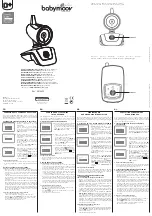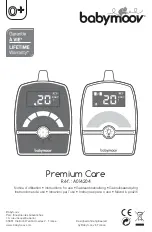
Receiver Cradle Inputs
16.
A/V Out Port
Connect the included A/V Cable to view
the receiver picture (when docked) on a TV or Monitor, or
record to a DVD Recorder or VCR. (
NOTE: The A/V output
function will not work if there is no power cable con-
nected to the cradle.
Only one A/V out port should be used
at a time).
17.
DC 9V Power Input
Connect the DC 9V Power Adaptor
(included) to the Receiver Cradle to power the receiver and/or
charge the Receiver (when docked).
NOTE: When the Receiver is docked, and the A/V Cable
is connected (power cable as needs to be connected),
the LCD Screen on the receiver will be blacked out. The
LCD screen will turn back on when the A/V Cable is disconnected.
Wireless Receiver Installation
Determine if you will be using the Receiver Cradle, or connecting the cables directly to the receiver
before installation:
1. Place the Receiver Cradle or Receiver in a place that will have clear reception with your
camera(s).
2. Plug the AC adaptor power output cable into the 9V POWER input of the Cradle or Receiver
Plug the power plug into a wall outlet or surge protector.
3. Leave the receiver to charge for
6 hours
prior to first time use so the built-in rechargeable
receiver battery is fully charged.
DO NOT
remove the power cable from the receiver / from the
cradle during initial charging process. After initial charge, charge as required.
4. If you wish to view the Receiver images on a larger screen, connect the included AV Cable to
the Cradle or Receiver, and connect the other end of the Cable to the Video IN (Yellow) and Audio
IN (White) ports on the TV, VCR or other viewing/recording device.
NOTE: the purpose of the AV output is for convenience only. When using with large screen
TV/Monitor, the picture might be grainy as the camera limits video resolution to VGA
(640x480 pixels). This is not a product defect.
For best performance use with TV/Monitor PIP
(Picture in Picture) function.
Check your TV/Monitor product manual to see if this feature is available on your TV/Monitor. This
allows you to view TV or other video source and see video from the camera in a small window
on the same screen.
Camera Installation
Before you install the camera, carefully plan where and how it will be positioned, and where you
will route the cable that connects the camera to the power adaptor.
Before starting permanent installation, verify its performance by observing the image on the
receiver when camera is positioned in the same location/position where it will be permanently
installed and the receiver is placed in the location where it will be used most of the time.
Installation Warnings:
Aim the Camera(s) to best optimize the viewing area: Select a location for the camera that provides
a clear view of the area you want to monitor, which is free from dust, and is not in line-of-sight
to a strong light source or direct sunlight.
Avoid installing the cameras where there are thick walls, or obstructions between the Cameras
and the Receiver.
16
16 17









































